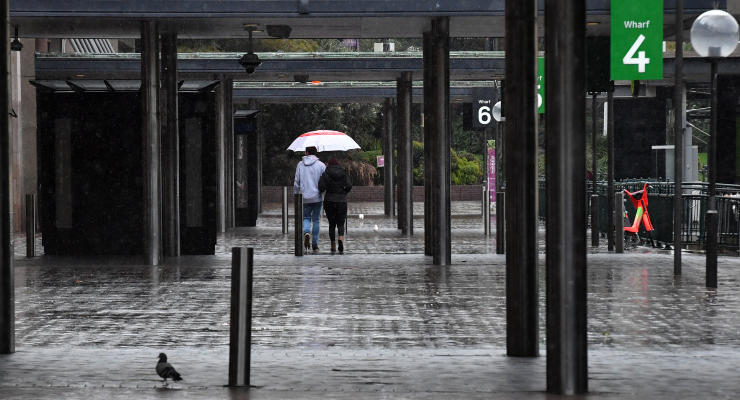
Two months ago, Treasurer Josh Frydenberg was triumphant. Delivering his second pandemic budget, he spoke of Australia’s strong economic performance during a pandemic that had devastated the world. Our recovery was looking V-shaped. And in spite of a slower than expected vaccine rollout, the country was on track for strong GDP growth.
But the key assumptions underpinning Frydenberg’s budget forecasts are already under pressure. An outbreak in Sydney has the country’s economic powerhouse facing weeks in lockdown, without the safety net of JobKeeper. Borders continue to slam shut around the country. The vaccine rollout stalls as Australia retreats further from the rest of the world. Just how badly will it pierce our plans for a rosy future?
What did Frydenberg assume?
Every budget comes with assumptions that underpin its forecasts for the future health of the economy. But the pandemic makes predicting the future fraught. The budget predicted GDP growth of 4.25% in 2021-22, and unemployment falling below 5% by 2023. But that’s contingent on the assumptions holding.
The budget papers assumed “a population-wide vaccination program is likely to be in place by the end of 2021”. Frydenberg initially said that meant every Australian who wanted a vaccine would have two doses by the end of the year. But both Frydenberg and Prime Minister Scott Morrison walked that back. Morrison later said Australia being fully vaccinated or not wouldn’t have a material impact on the budget. But Australia’s rollout is still slow, undermined by supply issues and confused messaging from politicians and health officials.
The next assumptions — that localised COVID outbreaks would occur but be effectively contained, and that most domestic activity restrictions would be lifted — have also collapsed. For that, we have to thank the highly infectious Delta variant, which got ahead of New South Wales’s stellar contact tracers. The current outbreak is yet to be effectively contained, and a lockdown could continue for weeks. Meanwhile, there have been outbreaks in nearly every capital city in the last month. Despite crushing a cluster, restrictions are only just finally easing in Melbourne.
The Sydney outbreak has also put a dent in another premise of Frydenberg’s recovery — that sustained state border restrictions would be avoided. Victoria yesterday shut its border to NSW, and residents of greater Sydney are locked out of the rest of the country. That will likely continue for the duration of the lockdown. More absurdly, the residents of the ACT, which hasn’t recorded a case in over a year and has tough restrictions on arrivals from NSW, are locked out of Victoria, Western Australia and South Australia.
Finally, the budget assumed a gradual return of migration from mid-2022, kickstarted by small-scale programs for the return of international students later this year. While there have been some proposals, that’s all undermined by Morrison’s decision to halve the international arrival cap, under pressure from state premiers.
Are we screwed? Maybe not
While the foundations for Frydenberg’s optimism might be rotting, there’s still some scope to maintain optimism about the state of the economy. Until the last two weeks, growth in economic activity and employment was better than the budget anticipated.
And even with Sydney facing an indefinite lockdown — estimated to cost the country $1 billion a week — the overall impact on GDP and employment in the longer term might not be so substantial, according to independent economist Saul Eslake.
“A billion a week sounds like a lot, but in a context of a $2 trillion economy, it’s not a lot of percentage points, and a good deal of what’s lost in the lockdown will be made up afterwards,” he said.
That’s based on Victoria’s experience, where the state rebounded strongly after more than 100 days of lockdown. But there’s a key difference this time around — Victoria had JobKeeper, allowing businesses to stay afloat. Without income support, more workers are choosing not to stay home, increasing the likelihood of the virus’s spread. The NSW government looks set to provide its own version of JobKeeper. Today, the federal government’s expenditure review committee is expected to approve a support package for NSW businesses.
Where Australia could well struggle is the vaccine rollout. While our comparative success over other advanced economies last year was a result of successful suppression (aided by an accident of geography) and effective fiscal stimulus, Eslake warns we’ve rested on our laurels, and deliberately opted for a slow rollout.
That means in spite of an improving economy and strong employment figures, in part a short-term result of almost non-existent migration, Australia has fallen behind the world, and could become increasingly isolated.
“We’re losing the race, and this time next year, we’ll not look so good compared with the rest of the world,” Eslake said.








Frydenberg’s excited announcements don’t gel at all with the frazzled small business and freelance people I and my wife have been dealing with the last season.
I don’t know who’s getting all the money – I am thinking that you really need to be the owner of an iron ore mine to be one of the winners in the current climate – but anecdotally all I am seeing are swathes of people unable to pay invoices, trying not to lose their businesses while drowning in debt, terrified that the next lockdown will be curtains for them, as well as another nail in the coffin for all the businesses who supplied them, and are not ever going to get paid.
People are being abusive, breaking down in tears, or trying to forestall the inevitable with lies. This does not feel like normal times. It certainly doesn’t feel like good times!!
Frydenberg has loved to brag about how wrong the naysayers were, who said we’d go off a cliff when JobKeeper/Seeker finihsed, but I don’t think he allowed enough of a time lag for the money to run through the system and end up with Woolies and Bunnings, where all money goes to die.
Now we’ve gone through the super, and the savings, and then after that, if there are more lockdowns, that economic cliff will be reached.
So if I was Joshie, I wouldn’t be crowing too loudly yet, and I wouldn’t be locking up the vault.
Dr Norman Swan on today’s corona cast discusses the modelling for how long New South Wales, Sydney in particular, can expect to be under public health measures. If Gladys and her mob follow the tough restrictions Victoria enacted it could be a month, if they continue on the piecemeal nonsense that Coalition ideology prefers, they could be going on until Christmas with the Gladys Delta variant
Surely by now voters are aware that the Coalition and their budget figures are complete bullshit! Costingsgate, just another Coalition scandal with no consequences except for the Liberal linkd accountancy firm involved.
When confronted on the bodgy costings of Leaner Hockey, the cigar smoker said “we have the fifth-biggest accounting firm in Australia auditing our books and certifying IN LAW that our numbers are accurate”.
Shadow Treasurer Hockey repeatedly described the work as an audit in the lead up to the election.
Documents seen by The Herald show the federal directors of both the Liberal Party and National Party would have known the claim to be untrue.
A Treasury analysis conducted at the request of the independents found the Liberal costings out by $11 billion as a result of errors including double counting and failing to account for the loss of dividends following a privatisation.
WHK Horwath was chosen. Horwath had as its founding partner Sir Charles Court, the long-serving Liberal premier of Western Australia and father of Richard Court, the Liberal premier from 1993 to 2001.
WHK Horwath atually began work on the federal Coalition’s costings in mid-June, well before its leader Tony Abbott announced he was abandoning Treasury and Finance and would instead have his policies costed by “a respected, reputable, well known accounting firm”.
The 2 accountants involved were fined! Simple solution to a big budget fix, and every budget including Frieds is a gourmet of rubbery offerings.
the Gold Standard as advocated by Berejiklian and Morrison where you put business money and greed before lives and health and even now they are doing just that
https://www.abc.net.au/radio/programs/coronacast/how-much-worse-is-it-going-to-get/13440768
Falling behind who precisely?
And what’s the metric?
If it’s population vaccination then sure, we can agree we haven’t covered ourselves in glory.
Stone cold last in the OECD.
If it’s the great “opening up race” who knows?
Sure the UK are about to let her rip.
And predicted daily numbers are north of 100 000.
Even with two thirds of the population vaccinated that’s a lot of cases-and every prospect of an overwhelmed NHS.
Well in the realms of science experiment.
I’m happy for us to be falling behind relative to the UK, much as I wish them well.
Economics and population health are indivisible.
That much is clear.
The future remains muddy as ever irrespective of how much economists wish it were otherwise.
Guardian Australia quoted the US head of Pfizer, a few days ago as saying something along the lines of … he’d offered the Australian government 20 million doses at a cost of $780m last June …enough to vaccinate every eligible Aussie twice…the powers that be from Morrison’s office refused because it was too expensive…he went on to state the cost in billions, the Morrison government have now spent on keeping businesses afloat, with Jobkeeper and other incentives (dealt with in Crikey on several occasions recently) and stated that, had they accepted the initial offer, we wouldn’t be in the situation we are in.
He was so right. My first thoughts after reading his words were, we must be the laughing stock of the world.
Now though, after further monetary announcements yesterday and today, I am more inclined to believe Morrison is on his way to a huge election win at the end of the year – backed to the hilt by his mate at AstraZeneca, (see Domain article 11 July ) and big and small businesses benefiting from the continued handouts.
A good marketing ploy after all?
And to hell with the rest of us.